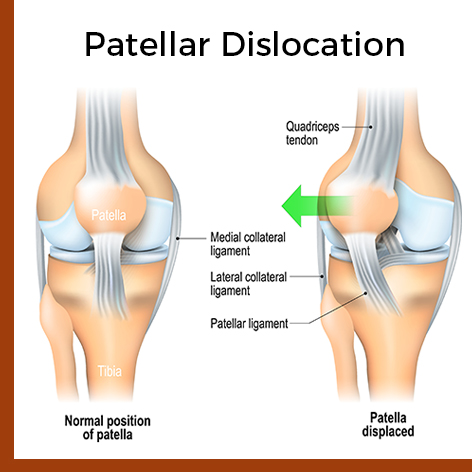Before we look at potential treatments, it’s helpful to better understand how the kneecap (patella) works, patellar pain symptoms, and the primary causes of injury. Collectively, pain in the front of the knee is typically referred to as Patellofemoral Pain.

What is Patellofemoral Pain Syndrome?
With a quick google search, you will see that Patellofemoral Syndrome is commonly referred to as “runners’ knee” or “jumpers’ knee.” However, although this type of knee pain is common among athletes, there can be many contributory causes of this syndrome. It differs from person to person: flat feet (pes planus), knock (valgus) knees, wide hips, weak thigh, hip muscles, abnormal bony alignment, instability, injury, etc.
Patients who experience patellofemoral pain syndrome report anterior knee pain (front of the knee). This pain is in the patellar region, also known as part of the extensor mechanism.
What are the symptoms of patellofemoral pain syndrome?
Symptoms typically start with dull, aching pain and become gradually worse.
Symptoms may include:
- Pain during activities that bend the knee, such as kneeling, squatting, or walking up or, most challenging, walking down a flight of stairs
- Crackling or popping sounds in your knee associated with pain
- Reduced thigh muscle strength
- Pain after sitting for extended periods
- Difficulty standing up from a chair or seat
The patella sees an average of 2.5-3.5 times your body weight with stairs and up to 7-8 times your body weight with deep squat.

What causes this knee pain?
Overuse, malalignment, or trauma can all cause patellofemoral pain.
A normally functioning patella glides smoothly over the femur (thigh bone) groove to create movement.
An abnormally aligned patella is deviated and may be “off-center” from the femur bone groove. When this happens, the kneecap does not glide naturally or smoothly over the groove, and this can lead to wearing of the joint surface (cartilage), a form of arthritis that can become very painful.
If left untreated, cartilage damage, also known as chondromalacia, can be a progressive problem. Cartilage damage on the kneecap’s underside can feel like crackling or catching as it becomes rough and fragmented as opposed to its normal smooth condition.
There are several causes of patellar malalignment: The principal cause relates to a patient’s underlying bone and joint shape. Some people are simply born with patellofemoral malalignment. Other factors that may contribute to this malalignment are overuse, flat feet, weak or tight muscles, tendons, injury, etc. An evaluation of one’s unique condition will always determine the best treatment options.
Common Risks Associated with Knee Pain
With patellofemoral pain, it is advised to have an examination by an orthopedic physician, allowing assessment of the structures and associated problems. Continuous use without treatment risks further breakdown of the cartilage behind the patella and can eventually lead to arthritis. Advanced degeneration of the patellar cartilage can make surgical replacement necessary.
Studies have shown that over 50% of patellar problems can be attributed to patellofemoral malalignment, causing stress and strain on the patella and other surrounding joints. Patients who have this condition correctly diagnosed can undertake a variety of treatments allowing them to get back to their normal activities.
Some treatment options include anti-inflammatory medications, bracing, exercises, biologically active injection therapies, physical therapy, and surgical intervention. Surgery may include arthroscopy, surgical repositioning of the kneecap, cartilage restoration, or at times partial knee replacement or resurfacing. There are anatomical, biological approaches, and prosthetic options available to treat or resurface the patella and femur as needed.
Treatment of patellofemoral pain requires a specific, individual diagnosis from a dedicated expert. After a diagnosis, a wide array of customized treatments can allow patients affected by anterior (front) knee pain to resume an active lifestyle.
About Davidson Orthopedics
 Dr. Davidson has a decades-long commitment to increasing the understanding and treatment options for patients with patellofemoral pain. He is a member of the International Patellofemoral Study Group, an exclusive group of experts dedicated to the study and treatment of patellofemoral problems. He provides comprehensive diagnostics and an ever-increasing roster of treatment options, ranging from relatively simple non-invasive treatments to complex surgical restorations. Of particular excitement in the past few years is the integrated usage of biologic injections into the knee, allowing improvement of the biologic environment within the knee, typically used effectively in conjunction with other modalities, allowing patients to maintain or resume an active lifestyle.
Dr. Davidson has a decades-long commitment to increasing the understanding and treatment options for patients with patellofemoral pain. He is a member of the International Patellofemoral Study Group, an exclusive group of experts dedicated to the study and treatment of patellofemoral problems. He provides comprehensive diagnostics and an ever-increasing roster of treatment options, ranging from relatively simple non-invasive treatments to complex surgical restorations. Of particular excitement in the past few years is the integrated usage of biologic injections into the knee, allowing improvement of the biologic environment within the knee, typically used effectively in conjunction with other modalities, allowing patients to maintain or resume an active lifestyle.
